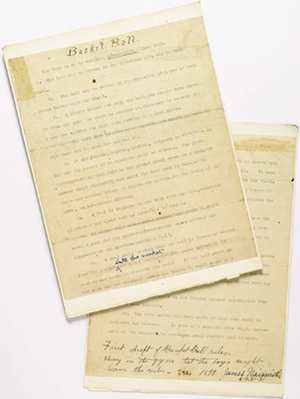- MENU
- HOME
- SEARCH
- WORLD
- MAIN
- AFRICA
- ASIA
- BALKANS
- EUROPE
- LATIN AMERICA
- MIDDLE EAST
- United Kingdom
- United States
- Argentina
- Australia
- Austria
- Benelux
- Brazil
- Canada
- China
- France
- Germany
- Greece
- Hungary
- India
- Indonesia
- Ireland
- Israel
- Italy
- Japan
- Korea
- Mexico
- New Zealand
- Pakistan
- Philippines
- Poland
- Russia
- South Africa
- Spain
- Taiwan
- Turkey
- USA
- BUSINESS
- WEALTH
- STOCKS
- TECH
- HEALTH
- LIFESTYLE
- ENTERTAINMENT
- SPORTS
- RSS
- iHaveNet.com
Danielle Arnet

The 2-page typed document listing rules for a new game sold for $4.3 million recently at Sotheby's New York. The game was basketball, and the teacher who created the rules in 1891 was James Naismith
Q: Any info on the origins of my antique high chair/stroller combo? It's a family piece. Value?
A: Thanks for the very clear images. They're a big help! From its simple design and basic stick construction, I'd date the mass-produced wooden highchair that converts to a push stroller to the first decades of the 20th Century.
The wood is hard to make out, but it does not appear to be oak. Perhaps poplar or pine. The cast iron wheels appear original.
Note the pattern of holes drilled into the seat. At one time, the surface where the baby sat was woven cane or rush. Such seats typically deteriorated with time -- and dampness. Many were then covered with tooled leather circles, such as the one on this chair. The replacements were a quick, lasting fix.
When pondering value, a smart collector thinks, "Who is the potential buyer?" Considering current child safety standards, a new parent is certainly not your target buyer. Beyond safety, considering the chair as a possible utilitarian piece is ludicrous. The spindles would be a nightmare to wipe down and clean.
Alternately, the buyer could be an antique lover who finds the combo charming. But it is big. It takes up space and collects dust. It seems, in 2011, to have no earthly use but as a plant stand.
There is a collector who could love the piece, and that's a doll person. Traditionally, that is the individual who buys antique high chairs, the better to display dolls.
But that buying pool is small and very, very picky. High chair hunters look for decorative, preferably over-the-top Victorian examples. Or they go for ones with technical innovations. Basic later chairs are a much harder sell.
Chairs that are top examples from a clearly identifiable period such as the 1950s, or clearly Edwardian or Deco-like chairs, are exceptions.
Prices for old baby chairs have, like much in the collecting arena, tanked. On the subscription database, www.worthpoint.com, we found that a decorative Victorian oak combo sold on
On the free site www.liveauctioneers.com, we found a Victorian chair combo with a solid seat that brought
In brief, the reader's chair has value as a cherished family piece. The open market is a different story. This is not the time to sell. If/when you decide to jump, be ready to take a hit unless you find a buyer who just has to have a basic early 20th C. chair combo.
Q: How do I sell my four "Pride of America's Indians" music boxes? They're from the Danbury Mint.
A: A set of eight plates, not musical boxes, with that title was released in 1986 by
Q: How do I find a buyer for my several dozen Zippo lighters? Most are never used, and most are Camel.
A: Zippo collectors -- and there are many --hunt online. Check completed sales on
AUCTION ACTION: Who could have dreamed back in 1891 that two pages of typed rules for a new game that 30-year-old James Naismith tacked up in a
Then a PE teacher at a
In 1898, Naismith brought the game to the
Sold by the Naismith family to benefit a family foundation that promotes good sportsmanship, his original rules were bought by
COLLECTOR QUIZ
Q: Naismith's first game was played with what equipment? How did the equipment later change?
A: The first game was played with a soccer ball and peach baskets. By 1906, the goals were metal hoops with backboards -- adopted to keep fans from interfering with the flight of the ball. Naismith, who became an ordained minister and medical doctor, lived to see his invention adopted as an Olympic sport in 1936. He died in 1940.